2023 Metheglin (Mead) in Detail
Last updated 07/20/2024
I’ve had 5 lbs of honey in the cupboard for months, as I had the intention of making a coffee mead. Then I was given a bottle of a coffee liqueur, and I’ve got a bunch of ports … so I decided to not make something similar to what I have more than enough of.
Plan B? I like a spiced apple mead that Starrlight Meadery makes, so emulating that sounded like a good idea. Last night I finally got around to starting it.
This post will be a bit different from previous “in detail” posts, as I will focus more on decisions and ideas than mechanics.
Menu (Dates of Activity)
| 08/24/2023 08/25/2023 08/26/2023 08/27/2023 08/28/2023 08/29/2023 |
09/01/2023 09/02/2023 09/05/2023 09/06/2023 09/07/2023 09/09/2023 |
09/30/2023 10/01/2023 10/16/2023 01/12/2024 04/11/2024 07/20/2024 |
08/24/2023
I have 50 or 60 g of Renaissance TR-313 and decided to you that. I made an overnight starter with 1 cup water at 95 F, 3.2 g yeast, 1/2 tsp Fermax nutrient, and 1 Tbsp sugar. This was mixed in a wine and let set on the counter for 4 hours.
A typical packet of yeast is 5 g, and since this batch will probably be 1-1/2 gallons, I went with a lesser amount.
I looked at it, and there was no activity. None. Zippo. I gave it a swirl and decided to let it set overnight.
08/25/2023
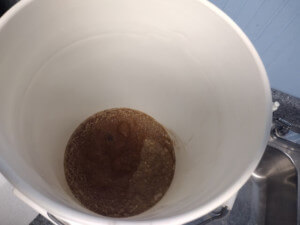 This morning I checked the starter — it didn’t start. Weird. So I tossed that starter and made another one, although I left the Fermax out. If I get any activity, I’ll add half a teaspoon.
This morning I checked the starter — it didn’t start. Weird. So I tossed that starter and made another one, although I left the Fermax out. If I get any activity, I’ll add half a teaspoon.
Thirty minute later, there’s no activity. Whoops! Is my yeast dead?
I opened a packet of Lalvin QA23 and poured that in the bottle. Five minutes later I had activity, so I added 1/2 tsp Fermax. Ten minutes later it was roaring.
A few hours later I diluted the honey with 2 parts water to 1 part hot tap water. I stirred until the honey was dissolved. Checked the SG, it was WAY high, so I added more water to make about 1-1/2 gallons. Stirred well, and checked the SG, it was still high. My target is 1.100.
So I kept adding water, stirring, and checking SG until I hit 1.100. The volume is close to 2 gallons, a bit more than I expected, but not a problem.
I stirred in 1 tsp Fermax, 1/2 tsp grape tannin, and 1 tsp acid blend. These amounts are based upon recipes and previous experience. Once fermentation is complete I’ll check pH and add more acid blend if I think it needs it.
I also added 1/2 teaspoon each of ground cinnamon, ground cloves, and ground allspice. These amount are a guess on my part — I want a spice aroma and flavor, but don’t want overwhelming. I suspect I could add more, and if so, I’ll add prior to bulk aging.
Four hours after making the starter I carefully poured it down the inside of the fermenter. Two hours after that I have evidence of fermentation.
08/26/2023
Fermentation is proceeding well. This morning there was a light foam on the must, about an inch thick.
The one problem with using ground spices is some floats on the foam. I will stir this back into the must 2 or 3 times per day. It’s not a lot, but I want it all in the must.
Many years ago I received a tip from a man who is the finest home winemaker I know. I take a clean paper towel, wet it with K-meta solution, and wipe the inside of the fermenter just above the must, and remove all visible debris. Anything on the sides of the container is a potential home for microbial life, so removing it reduces the chance of any infection, plus K-meta evaporates and is in the air above the must, which can’t hurt.
Note on nutrition: Although honey is supposedly the “perfect food”, that’s for humans and some animals. For yeast, honey is FAR from a good food source — it has no nutrients.
I’ve not read guidelines on the subject, but I add 50% to 100% more yeast nutrient than the package calls for, as honey has none of its own.
So far there was 1/2 tsp in the starter and I added 1 tsp to the must yesterday. At the next stirring later today, I will add another teaspoon. Tomorrow and Monday I’ll add another teaspoon each day.
Note: This post is “flow of consciousness”, e.g., I add details as I think of them. It’s not a good how-to on mead making, but by the time I’m done, it will have all the details I can think of.
08/27/2023
Fermentation is proceeding well. This morning there was a light foam on the must, about an inch thick. I added 1 tsp Fermax and stirred, then stirred again in the afternoon.
08/28/2023
I expected the fermentation was roughly half way through, so I checked the SG. Checking SG on small batches is difficult, as the wine isn’t deep enough to get a good amount of wine with the wine thief. I have to tilt the primary to make the wine deeper, and it takes half a dozen pulls to get enough to check the SG. This is among the reasons I don’t check SG as often during fermentation.
In this case, it was a good choice, as the SG is 1.040. I’m going to check it again tomorrow, and if it’s near 1.020, I’m going to rack into a pair of 4 liter jugs to finish up.
08/29/2023
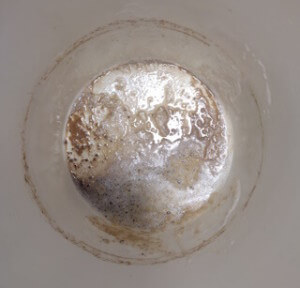
As intended, I checked the SG and it was right at 1.020.
Something to consider is the difficulties of pulling samples when the batch is small AND when there are chunks in the must. In this case I had both problems.
The batch itself is under 2 gallons, so I tilted the primary at a 45 degree angle, and held the FermTech wine thief along the side of the container, to get the most wine in each pull. This was emptied into a hydrometer test jar. I had to repeat this half a dozen times to get enough wine to float the hydrometer.
The second problem is chunks. A lot of the spices dropped as sediment. It may not be clear in the picture on the right, but all the sediment is dark brown, and there are large pieces.
I used pre-ground cinnamon and allspice, but ground the cloves in a rotary coffee grinder. The cloves was not fine particles like the cinnamon and allspice, and chunks kept getting caught in the thief, so it wasn’t holding wine. I had to run it under water, upside down, to dislodge the particles.
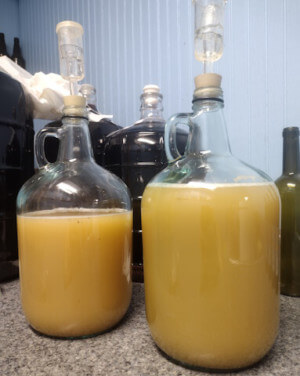
Next I racked the wine into a pair of 4 liter jugs, with neither full as the wine is still fermenting. Filling the container too full is a great way to overflow the wine into the airlock, and onto the counter.
The wine is perfectly safe from O2, as it’s emitting a LOT of CO2. After affixing the airlocks, I gave both jugs a good swirl to release CO2. In the near future the CO2 will put all air out of the jug, so a blank of CO2 will protect the wine.
Note that the CO2 mixes with the air in the jug quickly upon its release from the wine. My supposition is this extra volume pushes whatever gases are at the top of the container out the airlock. This happens continuously, so eventually the percentage of air (containing O2) is so minimal as to be no danger.
I’m going to let the wines rest for 2 to 3 weeks before racking again. At that point the fermentation should be complete.
Note regarding airlock activity — bubbling in the airlock does not provide any useful information. The bubbling may be due to active fermentation, the post-fermentation wine degassing, a change in temperature or barometric pressure, or possibly some other reason I have not thought of. The SG tells me if the wine is fermenting or not, and in the weeks or months post-fermentation, I assume any activity indicates degassing.
09/01/2023
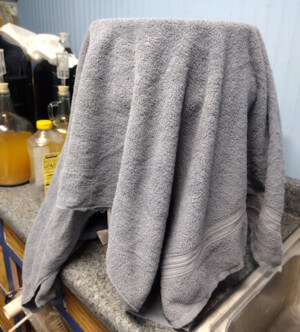
I was going to make a second batch of mead to test the viability of the TR-313, and coincidentally fill a 3 gallon carboy by combining the new batch with the original batch. I scrapped that idea and instead of purchasing 5 lbs of honey, I purchased 10 pounds. The plan is to fill a 23 liter carboy. This wine is referred to as “Batch #2”. The original batch is “Batch #1” hereafter.
Batch #2:
Essentially I repeated all actions for Batch #1, except for doubling most ingredients. One change is that I added 1/2 tsp ground nutmeg, to give the mead a more “apple pie” flavor.
I also diluted the honey more, targeting SG 1.090 instead of 1.100. This drops the ABV by about 1.5%, going from a bit over 14% to just over 12.5%.
I’ve been making a lot of heavy reds with higher ABV, and the target for Batch #1, SG 1.100, is a bit stronger than I want for this wine. The final result after blending will be about 13% ABV, and after backsweetening it will be a bit lower.
The picture is what my primaries tend to look like. I use an old bath towel to cover the fermenters. The goal is to allow air in, as yeast needs O2 for reproduction, while keeping everything else out. Use of a bigger towel utilizes the towel’s weight to hold it in place.
I inoculated 5.5 hours after creating the starter. I could smell fermentation an hour later, although there’s little visible evidence.
09/02/2023
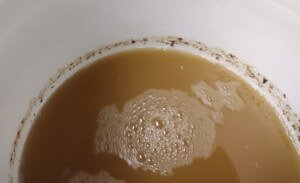
Batch #2:
A bit over 24 hours after inoculating, I checked the wine.
Walking down into the cellar I could smell fermentation. It was not strong (certainly not the smell of ~700 lbs (317 kg) of grapes fermenting!), but it was there. Yet when I looked in the fermenter, there was no visible activity. No foam, no turbulence.
Then I noticed that there were particles on the container, just about the must. This indicates that at some point, there was foam about 3/4″ (1.9 cm) high. The photo at right shows this.
I also checked the SG — it was 1.070, meaning that the SG dropped 20 points in just over 24 hours. Yes, there is active fermentation.
Next I stirred the must, then used a clean paper towel wet with K-meta solution to clean the residue from the fermenter. This removes a possible location for hostile microbial life to live.
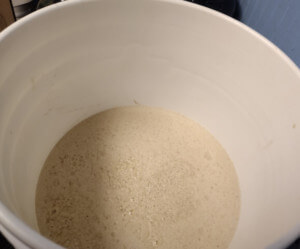
Honey is completely lacking in nutrients for yeast, which is why I basically double the amount added. I dumped 4 tsp Fermax into the must.
Yes, I dumped the nutrient into the must. And it foamed up.
Normally I gently sprinkle additives on top of an active fermentation. This avoids foam up, although in this case I did it purposefully to capture a photo.
What can happen is that the additive, a powder, can act as nucleonic sites for CO2 to adhere to, which effectively expels a lot of CO2. Folks have dumped additives into a fermenter that is three-quarters full, and had it boil over. This typically requires a lot of solids in the wine, so careful sprinkling is best. Note that this can happen to juice, not just wine made from grapes or other fruit.
I felt safe in this instance, as honey has few particles AND the fermenter is just about half full. There is a lot of room for expansion.
As the photo shows, my action produced about 1/2″ (1.25 cm) of foam. I do not recommend this approach — sprinkle everything gently onto active ferments.
09/05/2023
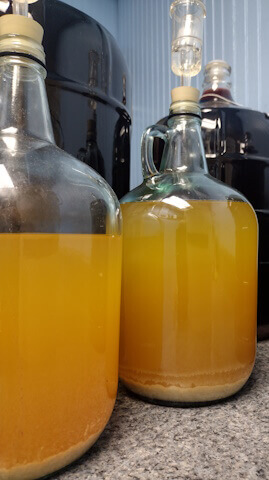
Batch #2:
I’ve been stirring the must twice per day, and it’s perking along. I figured it was around 1.020 as of this morning, so I checked SG — 1.015. Perfect time to rack into a secondary container.
I sanitized a 23 liter carboy, which is plenty large enough to hold all the mead so far, then racked out of the primary.
As I’ve said in other blogs, my first rackings are “dirty”, in that I don’t worry about transferring a bit of sediment. It dropped once, it will drop again. My concern is not throwing away good wine.
Every racking wastes wine — it’s the nature of the beast. So racking carefully and racking as few times as feasible limit the losses.
Batch #1:
As the photo shows, Batch #1 is clearing nicely, in that sediment is dropping. The wine itself is still opaque, but that will change with time. Mead may need help in clearing, but I’m not worrying about that now. That’s a future concern.
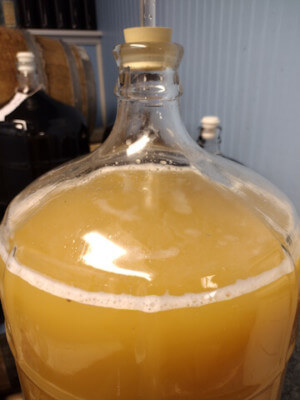
The fact that the wine is clearing indicates fermentation is complete. At this time I’m not taking a SG reading, as it doesn’t matter.
I took a tiny sample, and for a very green wine, it tastes good. There’s still a lot of CO2 in it, which gives it a sharp tang, and it has a lot of chemical changes to undergo before it will approach drinkable.
I poured the wine into the carboy with Batch #2. I left most of the sediment behind, but erred on the side of keeping wine versus eliminating sediment.
As the photo shows, the carboy is roughly 3 liters short of being full. I can either:
#1: downsize to a 19 liter carboy
#2: add a different wine to fill the carboy, or
#3: make some more mead.
I’m going with Door #3. It makes more sense to me to get some more honey and start yet another smaller batch.
Please note this is NOT good batch planning. My original intention was to make a small batch, then I wanted to test the TR-313 yeast, then I decided to fill a 23 liter carboy. Changing plans in mid-stream is not the smoothest choice. However, this is going to work out fine.
Batch #3:
After work I purchased 3 lbs of Aldi’s raw honey, which I diluted to just over 1 US gallon, achieving an SG of 1.090. To that I added 1 tsp Fermax, 1 tsp acid blend, and 1/4 tsp grape tannin. I did not add any spices.
For the starter I used 1 tsp TR-313 (2.4 g), 1/2 tsp Fermax, and 1 Tbsp sugar in 1 cup 92 F water. I let this perk for 5 hours, then inoculated.
09/06/2023
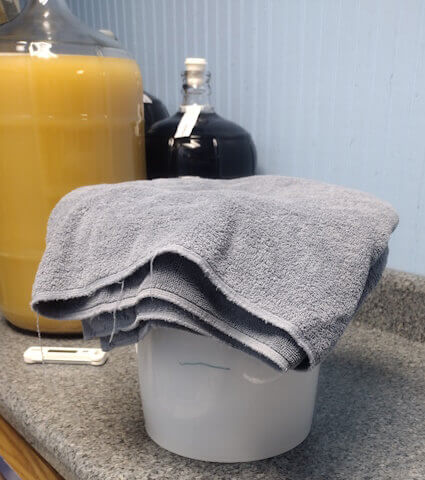
Batch #3:
This morning I stirred Batch #3. I didn’t bother checking SG, and probably won’t until Friday.
It had more foam on top that previous batches, probably 1″ of very airy foam. It’s also noticeably darker in color than the Costco honey.
This is not a surprise, as honey varies dramatically by region and by the pollen source. In addition to being darker, this one has a heavier flavor, and should made an interesting addition to the mix.
The foam is yeast hulls and solids from the honey — this one may have more solids than the Costco, so more material with which to build foam.
I’m fermenting in a 2 gallon bucket I got years ago in a small kit. I wish I had more of them.
For the towel, I took the bath towel I used for the other batches and folded it in quarters, then dropped it on top. It’s not a tight seal, and probably will let less air pass. To compensate, I’ll stir 4 times per day.
I should probably use a smaller towel and will swap it out later.
09/07/2023
Batch #3:
Added 1 tsp Fermax and stirred.
09/09/2023
Batch #3:
I checked the SG — it was down to 1.015, so I racked the wine into a 4 liter jug, leaving some headspace since the fermentation is active. There was a bit remaining, which I added to the 23 liter carboy.
Batch #1/#2:
Fermentation is complete as the top of the wine is clearing. I added 1/4 tsp K-meta.
09/30/2023
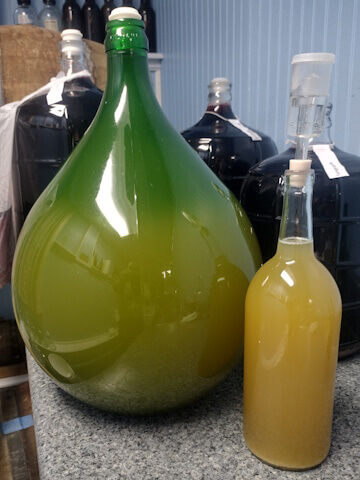
I was out of sorbate, so I couldn’t back sweeten the wine last weekend as I had planned. I stopped at American Brewmaster this morning to pick up a few things, including the smallest package of sorbate they have. I write the date on the package when I buy it, and 12-15 months later whatever is left gets binned. Sorbate has a limited shelf life, and I much prefer to buy fresh than have an entire batch ferment in the bottle.
I homogenized batches #1/#2 and #3. The spices are a bit raw, but not bad. I expect that to mellow with time. It definitely needs backsweetening.
Next I added a double batch of K-meta as I didn’t plan on racking for 6 months, then 2 tsp sorbate and 2-1/2 tsp bentonite dissolved in 2 cups hot water. Then I added 3x 12 oz cans frozen apple juice (defrosted), which popped the SG from 1.000 to 1.009.
I made a mistake here — I should not have added the K-meta or bentonite, as I want to add pectic enzyme to address any pectin in the apple juice. According to sources I read, these 3 items are not friendly. I should have added the pectic enzyme today, K-meta tomorrow, and bentonite on Monday.
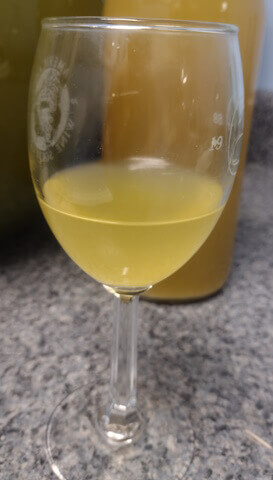
The wine fills a 25 liter (6.6 US gallon) demijohn with a 1.5 liter bottle leftover. When I rack off the sediment, I’ll probably have just the demijohn.
Tomorrow I’ll with draw enough that I can add the pectic enzyme and stir, then replace the wine.
Interestingly enough, 3 cans of apple juice concentrate were not enough. I wanted more apple flavor that the wine does not have. I’m not doing anything now — I’ll let the wine rest 3 months, then taste test.
Overall, the metheglin is good. It’s obviously very young, but has a nice clean taste with the spices (cinnamon, cloves, allspice, nutmeg) and a bit of apple. I expect I’ll be pleased with this one, regardless if I add more apple concentrate or not.
At this time, it’s not clear. Pectic enzyme will break down any fruit pectin so that will precipitate. Pectin can make the wine cloudy, and many moons ago I had silver ribbons in a cherry wine. I added pectic enzyme and the wine cleared in a matter of hours.
One issue with mead is proteins from the honey. The tannin I added pre-fermentation will help, and the bentonite should solve the remainder of that problem. We’ll see what the wine looks like in a week or so.
It looks like the wine is already clearing, but the color and shape of the demijohn make that difficult to determine. When I withdraw a sample tomorrow to add the pectic enzyme, we’ll see.
10/01/2023
Withdrew a large sample of wine, added 4 tsp pectic enzyme, stirred, then restored the sample.
10/16/2023
I poured four 12 oz cans of defrosted frozen apple juice concentrate into a primary with 1/4 tsp K-meta, then racked the wine into the fermenter, and stirred to blend.
This added the apple flavor I was seeking and muted the spice flavor, which was previously overwhelming. I racked back into the 25 liter demijohn for bulk aging.
I’ll taste test in 3 months.
01/12/2024
Added 1/4 tsp K-meta. I removed 1 cup wine, added the K-meta, and stirred lightly. Then poured the reserved wine back in.
04/11/2024
Added 1/4 tsp K-meta, using the same method as last time.
07/20/2024
Racked, adding 7 oz glycerin and 3/8 tsp K-meta. Bottled.
Final SG: 1.018
Residual sugar: 4.8%

